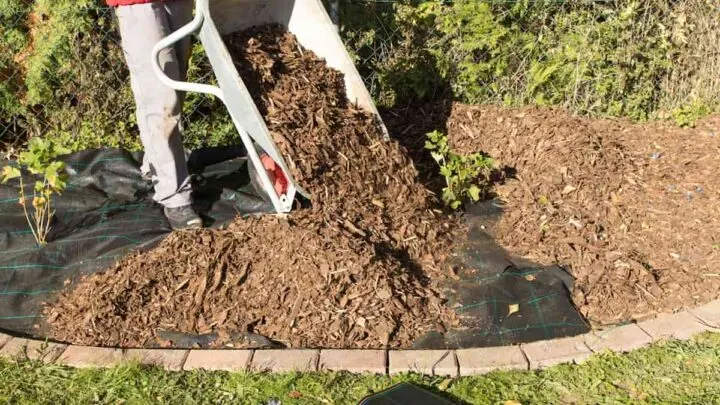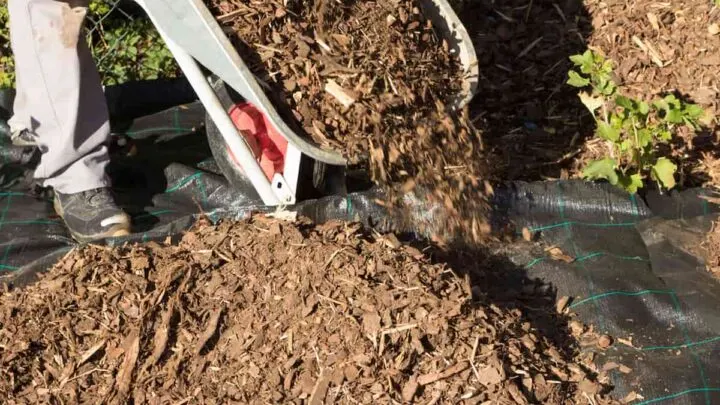Many gardeners practice the technique of mulching, and they swear that it’s helpful in many different ways. By spreading a layer of mulch over the soil in your garden beds, you are doing your plants a favor. When it comes to soil erosion, several methods have been created to protect against it, and mulching has been brought into that equation. Is it beneficial? You must want to know, can mulch prevent soil erosion?
Mulch can prevent soil erosion. Hard rain, hail, and high winds will erode your soil over time. Placing a 1-2 inch layer of mulch directly over your soil acts as a barrier and protects it from uncontrollable, harsh weather. It also ensures that your plants will receive all the nutrients they need from the soil by keeping it in place and preventing it from withering away.
Keep reading to learn more about mulching and how it can be used to prevent soil erosion.

Mulching Materials That Best Prevent Soil Erosion
Straw:
Straw is most likely the cheapest option to be used as mulch in your garden beds. If you have smaller surfaces to cover, you can break up bayles by hand and spread them evenly across the surface.
Bigger gardens may require a blower to break the bayles apart and scatter the straw evenly onto a larger surface area. Because of how light straw is, it is recommended that you use a tackifier such as a guar. Not only will it help with water retention, but it also provides your straw mulch with extra nitrogen.
Compost:
If you don’t already have a way to produce your compost, it could be higher in the cost range; but it’s worth it. Compost is a great material to use and mulch and to protect your soil from erosion. Compost is produced through a collection and breakdown of different organic matter.
This can include animal manure, yard waste, and even kitchen scraps. Most experienced gardeners have compost bins that might be filled and ready to use as mulch. Specifically, grassy areas are known to thrive if their soil areas are covered in a 1-2 inch layer of compost as mulch.
Wood Chips:
Wood chips are simply trees that have been ground down into shavings. If you have had trees taken down on your land, you may be able to produce your wood chips. If not, many construction sites where land has been cleared may give them out for free. They are meant to be used as temporary mulch to prevent soil erosion and not as permanent mulch.
For example, they would not do well in a vegetable or fruit garden. As the wood chips decompose in the soil, they can pull away the nutrients from the plants and cause them to die or not produce. Wood Chips are better used when sprinkled lightly around bushes, trees, and other larger plants that are older and more established.

Other Similar Ways to Prevent Soil Erosion
Although mulching is simple and usually affordable, other techniques to prevent soil erosion may be useful to you. You can also pair any methods below with mulching if you’ve noticed extreme soil erosion in your gardens.
- Matting is very similar to mulching in that organic material is spread over the soil surface, except it takes it one step further. The matting technique uses netting to ensure that the mulch layer stays intact. The netting must be anchored so that the wind doesn’t lift it. Matting guarantees that the mulch can decompose into the soil and release all nutrients, resulting in a healthier garden.
- Ground covering is another technique used by many advanced gardeners. It uses ground-covering plants such as grass, herbs, and flowers to cover the soil’s surface. The roots of the plants will also work their way down into the soil and develop an intricate system that will hold the soil in place. It strengthens the soil and protects it from harsh weather and erosion.

- Terracing can be paired with mulching to guarantee soil protection from soil erosion. Many gardens that slope struggles to retain life. Soil and plants can eventually fall down the slope, so terracing is a great alternative. It’s creating steps out of a hill or sloped piece of land to create flatter surfaces to garden in. You can compare terracing to stairs, just on a larger scale. You can also use mulch on a terraced garden. The mulch will be able to perform its duties even better. The walls of the terrace will act as a shield from the wind.
Last Thoughts:
Mulch is a great method to use when preventing soil erosion. There are many different useful materials for all different budgets that can be used as mulch. They will act as a protective barrier from harsh weather conditions and provide fertilizer to the soil, making it stronger and healthier for the vegetation growing within it.
Mulching can be paired with other methods such as terracing and matting for even more insurance that your soil will be protected from erosion. Don’t be afraid to try multiple techniques to guarantee your garden will stay intact, especially if you live in an area with lots of rain and wind.
Keep in mind that it’s important to do your research and choose the best type of mulch for the specific plants you are growing. You may also consider using thicker layers of mulch in sloped gardens. The heaviness will prevent the mulch and the soil from rolling down any hills.
Overall, mulching is good for many gardening needs, and preventing soil erosion is one of them. Try the technique out for yourself and protect your soil.

Hi there, my name is Allie and welcome to my blog; GareningWithAllie!
Much of what you see written here is just our personal experiences with gardening. Along with the content I write here, there is also a unique collection of gardening topics covered by some of our close friends. I hope you find everything you read here to be helpful, informative, and something that can make your gardening journey the most lovely experience ever! With that said, Happy Gardening!
